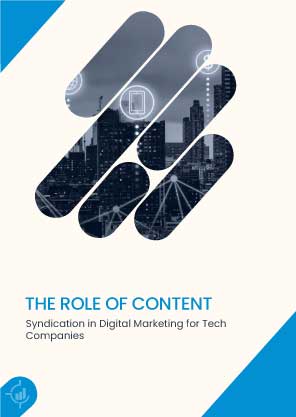or call: +1 (845) 347-8894

or call: +1 (845) 347-8894

Tech buyers in 2025 don’t just browse, they investigate. They dig into content that informs, validates, and guides critical purchase decisions. But creating a great whitepaper or webinar is only half the equation. The other half is getting that content in front of the right audience at the right time. That’s where Content Syndication in Digital Marketing enters as a force multiplie,r not a filler tactic.
For tech companies navigating long buying cycles, niche audiences, and high CAC (Customer Acquisition Costs), content syndication isn’t just a traffic play, it’s a revenue growth strategy.
Many tech marketers still view syndication as a one-dimensional lead dump. Push out a report, collect a few hundred contacts, hand them to sales, and hope for conversions.
This outdated approach misses the mark. Today, Content Syndication in Digital Marketing must reflect two realities:
Smart syndication is no longer about mass exposure. It’s about strategic placement—putting the right asset in the hands of a VP of Infrastructure two months before they hit the RFP stage.
A mid-market cloud platform provider launched a content syndication campaign for their Kubernetes optimization toolkit. Rather than blast it across general IT sites, they partnered with a niche DevOps newsletter, targeting subscribers with a history of engaging with containerization content.
The result?
The takeaway: Content Syndication in Digital Marketing works best when context, audience alignment, and timing intersect.
Before syndicating anything, ask: Would I exchange my business email for this?
If your whitepaper simply rehashes trends already published by Gartner or Forrester, don’t syndicate it. Instead, syndicate:
These assets do more than generate leads—they build authority and nurture trust.
Many tech marketers view syndication as a top-of-funnel lever. That’s only half true. When orchestrated well, Content Syndication in Digital Marketing supports every funnel stage:
Here’s what often goes unspoken: Syndicated content acts as pre-sales collateral. Buyers evaluate vendors silently before outreach. If your content is helpful and well-placed, it becomes a silent sales rep.
Let’s move beyond definitions. Here’s a framework that modern tech marketers can use:
Stop thinking in terms of “targeting CIOs at Fortune 1000s.” Start with problem-based segmentation. For example:
Instead of simply targeting based on title and industry, ask: What real-world problem is this content solving? Are we helping a VP of Security reduce threat dwell time? Are we enabling a DataOps lead to modernize their pipeline?
When you structure your segmentation around buyer priorities, not just firmographics, you’re more likely to connect with urgency. This focus allows you to map assets directly to in-flight initiatives. The result is not only better alignment but also higher downstream conversion.
Instead of syndicating one PDF, syndicate a sequence:
This builds narrative continuity and signals deeper intent. If someone downloads all three, you now have a strong behavioral signal that they are seriously evaluating a solution like yours.
In tech, buying isn’t linear. A dev manager may first explore a use case, then share a guide internally, and only later attend a vendor-hosted webinar. Your syndication program should anticipate and support this path, not disrupt it with sales outreach too early.
The first email after syndication shouldn’t be a sales pitch. Instead:
For example, if someone downloads your guide on multi-cloud resilience, don’t just say, “Thanks for downloading, let’s talk.” Instead, send a brief note: “Most teams reading this are thinking about data portability. Here’s a quick checklist to help.”
Marketers who personalize their first three touches based on the asset topic see a 2x lift in SQL conversion.
Most marketers know TechTarget, Foundry, and NetLine. But what about:
These niche channels often have higher signal-to-noise ratios and better engagement, especially for technical audiences.
Forget just CPL. In 2025, here’s how to measure syndication impact:
For example, one AI analytics platform found that leads who downloaded their syndicated cloud integration checklist moved to demo 40% faster than webinar registrants.
Why? Because the checklist aligned with a specific stage of their buyer journey and solved a real problem.
Even in 2025, tech marketers fall into traps that neutralize syndication ROI:
The frontier of Content Syndication in Digital Marketing is autonomous. Imagine this:
This is already being tested using AI + behavioral analytics. We’re entering an era of self-optimizing syndication, where the best content finds the best audience, without manual routing.
To win in 2025, tech marketers must stop treating syndication as a one-off campaign. Instead, build a content syndication system one that connects content creation, audience intelligence, distribution channels, and post-download journeys.
Done right, Content Syndication in Digital Marketing becomes a compound asset. Every asset you create doesn’t just drive leads it builds momentum, trust, and long-term revenue outcomes.
That’s not just better marketing. That’s sustainable growth.
Content syndication distributes your valuable content through third-party platforms to reach targeted buyers. It’s not an ad, it’s a lead generation tool built on trust and education.
Syndication places content in front of decision-makers actively researching solutions. Leads are opt-in, vetted, and often mid-funnel, making them more likely to convert.
High-performing assets include research reports, how-to guides, migration playbooks, and ROI tools. Buyers engage more when content solves real problems.
Use firmographic, technographic, and intent filters. Focus on pain points, job roles, and the buying stage, not just company size or industry.
Skip the sales pitch. Reference the downloaded asset, offer related content, and ask an open-ended question tied to their use case.
To participate in our interviews, please write to our IntentTech Media Room at sudipto@intentamplify.com




